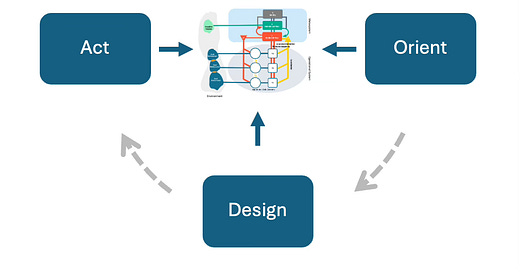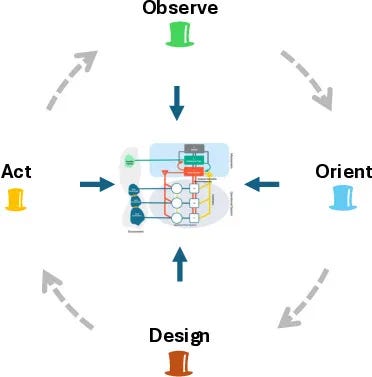Spoiler alert: OODA is not a Loop
My educational installation is to blame. The installation consists of my rowing machine in the basement and an iPad - so that I have a reason to get up and exercise every morning. I always choose a topic that has to do with my work but is not topical. This has resulted in a few blogs, which I publish here in a loose series.
I've known about the OODA Loop for a while - or so I thought. Nice idea, interesting for those interested in military topics. Then I came across an interesting YouTube discussion about OODA, which sent me on a journey of discovery on the subject of situation awareness and its sister topics of sensemaking and weak signal detection.
The OODA Loop is useful for navigating complex situations. It emphasizes the importance of a holistic approach to decision-making and encourages individuals and organizations to continuously adapt their understanding of the situation and their actions based on new information. This dynamic nature is crucial for maintaining a high level of situational awareness, particularly in rapidly evolving environments.
What is OODA
The OODA Loop is a tool developed by military strategist and United States Air Force Colonel John Boyd. OODA stands for Observe, Orient, Decide, and Act. The loop emphasizes the importance of adapting quickly to changing situations through a continuous cycle of interactions.
Typically, it is drawn like above.
Observe or Sense (Analysis) – Gathering information and understanding the current environment and situation: In Observe mode, you focus on understanding the current situation. This section helps you dissect and comprehend an organization’s various elements and dynamics, paving the way for insightful analysis.
Orient (Diagnosis): Analyzing and using the information to update your view of reality. While the analysis does not directly imply an assessment, the main focus of the diagnosis is developing an opinion about the findings.
Decide (Design) – Making decisions based on observations and orientation: Finally, we delve into organizational design. This part guides you through the critical decisions involved in proposing changes and improvements to an organization’s structure and processes, utilizing the principles of VSM.
Act (Ways of Change)- Taking action to implement the decision: Last, we choose a procedure to implement the findings. This can mean a traditional change process or an iterative approach. We discuss some of the options and the reasons why you would choose one over the other.
After taking action, the loop restarts with observation to assess the actions’ success and react to any situation changes.
The process helps to control the “blast radius,” i.e., the impact of an intervention. The loop allows interventions to be treated as experiments. It is intended to be performed rapidly and continuously, allowing quick reactions and flexibility in response to a situation’s dynamics, leading to improved strategic outcomes.
The OODA Loop is not a Loop.
What looks like a linear process in this illustration is much more complex and open. In any case, the OODA loop is not a loop; the popular understanding of the OODA loop as a simple, circular decision cycle that favors speed is simply wrong.
However, the OODA process is not circular… Military forces do not in practice wait to observe until they have acted. Observation, orientation and action are continuous processes, and decisions are made occasionally in consequences of them. There is no OODA loop. The idea of getting inside the enemy decision cycle is deeply flawed.
Observation, orientation, and action are continuous processes; the idea of simply “getting inside the enemy’s decision cycle” is flawed.
It is an open system: you can enter and exit it anywhere.
Any “phase” can become current, depending on the situation. This dynamic nature keeps you engaged and active in the decision-making process. A simple example would be the famous hand on the hob. This certainly does not lead to you orienting yourself, designing the reaction, and then taking your hand off the hob. Instead, it is a sequence of sense -> act.
But there is no automatic cause of pain here, either. I modified the example slightly so that the Christmas tree burns. I may grab it anyway and throw it out of the patio door.
In Boyd’s view, there are many loops at different speeds simultaneously; the opponent reacts in the same way and, in turn, forces me to respond. OODA is a holistic checklist and reminds us not to run off at the first observation but to invest time, willpower, and energy in assessing the situation. This investment is valuable and can lead to more informed decisions.
Boyd’s concept of orientation went beyond simply understanding the current situation. It involved integrating observed data with existing mental models, cultural biases, and past experiences to develop a comprehensive and nuanced understanding of the unfolding situation. This deep level of orientation was essential for making effective decisions and acting swiftly in complex and dynamic environments.
The OODA Loop is a set of Views. Perhaps a better picture than a loop is a situation in which we continuously view the system in focus with different “hats,” i.e., perspectives, and are always ready to integrate contributions from every perspective.
A broader view
For Boyd, OODA is part of developing a mental model of the current situation. Creating relevant mental concepts requires constant improvement and adaptability of existing mental models.
The Importance of “Orientation”
Boyd’s concept of “Orientation” is crucial, he placed significant emphasis on the “Orient” viewpoint. He believed that an individual’s or organization’s ability to rapidly and accurately orient themselves to the situation was the key to gaining a decision-making advantage.
Boyd about Survival and Adaptivity
Boyd’s concepts revolve around themes of organizational survival and its solution – adaptability. He portrays
A system must be able to change and adapt as conditions require.
Adaptability is linked with the need to understand one’s own relative power position (shih).
“The
About John Boyd
John Boyd (1927-1997) was a famous fighter pilot in the US airforce. He served in Japan and Korea. The lessons he learned and the work he did in Korea formed the foundation for much of his later work, including his theories on air-to-air tactics, energy maneuverability, aircraft design, OODA loops, strategy and maneuver warfare, and his thoughts on time and thinking itself.
A Discourse on Winning and Losing (also known as The Green Book) which includes four briefings and an essay.
Patterns of Conflict, a historical analysis of warfare and theories for victory.
Organic Design for Command and Control, which focuses on cooperation in complex, fast-moving situations.
The Strategic Game of ? and ?, which emphasizes the mental twists and turns for realizing aims or purposes.
The Conceptual Spiral which uses examples from science and engineering to discuss self-correcting mechanisms.
The Essence of Winning and Losing which offers a picture of the OODA loop.
Sources
The best way to explore the work of John Boyd is probably: Osinga, Frans P. B. 2007. Science, Strategy and War: The Strategic Theory of John Boyd (Strategy and History). Taylor and Francis
A deep dive into practical applications of the OODA loop is: OODA Loopers on Youtube
This is part of my mini-series "The sisters of understanding". Here is the outline and preliminary scope.







